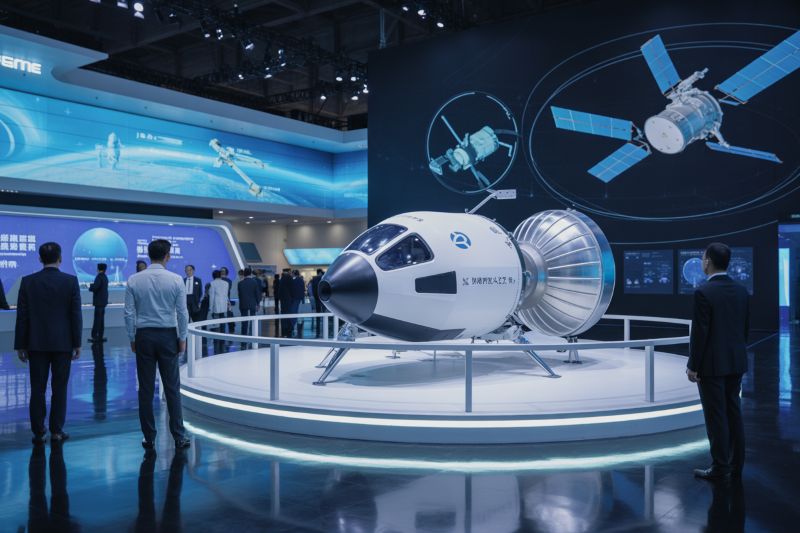Published on
November 6, 2025

From November 14 to 16, 2024, at the Shenzhen World Exhibition and Convention Center, the 27th China International High-Tech Fair will take place, and for the first time, the Chinese Fair will offer Space Travel. This will showcase a new order of China’s enthralling commercialized technologies. China will offer the first installment of the recently Chinese commercialized space technologies. Traveling to space, a fantasy few will soon will become a realization for many.
Shenzhen Tech Fair: A Hub of Innovation
The 27th edition of CHTF will cover a vast 400,000 square meters of exhibition space, featuring 22 specialized zones that will highlight a wide array of cutting-edge technologies. From national-level projects and artificial intelligence to semiconductors, the low-altitude economy, and commercial aerospace, the fair promises to be a major event for global technology enthusiasts, innovators, and business leaders alike. With a projected attendance of around 450,000 visitors, the CHTF is poised to attract significant attention not just from the tech community but also from international travelers with an interest in emerging technologies.
China’s Space Tourism Initiative: A New Era of Commercial Space Travel
The China Aerospace Science and Technology Corporation (CASC), one of the nation’s most prominent space agencies, will be at the center of the space tourism announcement. At this year’s fair, CASC will unveil its ambitious space tourism initiative, marking the country’s entry into the commercial space travel market. This development comes as part of China’s broader push to become a global leader in space exploration and innovation.
Space tourism, once a dream of the future, is now becoming a reality with China’s foray into the industry. As private companies and governmental organizations around the world develop new ways to make space travel accessible to tourists, China’s participation will have significant implications for both the space industry and the tourism sector. The introduction of space tourism will not only attract tech-savvy travelers but also inspire a new generation of explorers eager to experience the wonder of space.
Impact on Travel and Tourism: Opening New Frontiers
The debut of China’s space tourism project at the Shenzhen fair represents a major milestone in the evolution of the tourism industry. Space tourism is expected to attract a niche group of travelers looking for extraordinary, once-in-a-lifetime experiences. Just as suborbital flights by companies like SpaceX and Blue Origin have captured public attention in the West, China’s entry into the space tourism market will contribute to the global expansion of this emerging sector.
The potential for space tourism in China could significantly boost the country’s economy and tourism industry. As one of the most populous nations in the world with a rapidly growing middle class, China has the market to support space tourism. Space travel, once the domain of astronauts, is increasingly being marketed to affluent consumers seeking unique experiences. For China, this will mean not only attracting international tourists but also establishing itself as a leader in the global space tourism economy.
The launch of China’s space tourism initiative is likely to spark a wave of international interest. Just as space tourism in the U.S. has generated excitement and anticipation, China’s involvement will open up new travel opportunities for global tourists. It could pave the way for the development of spaceports within the country, providing the infrastructure needed for the commercialization of space travel.
The Role of State-Owned Enterprises in Advancing Space Tourism
At the fair, CASC will not be alone in showcasing its technological advancements. The event will feature over 40 other major state-owned enterprises, such as China Southern Power Grid, China Rare Earth Group, and China Electric Equipment Group, all of which will present their latest innovations in technology and equipment. These companies are part of the broader effort to advance China’s technological capabilities, many of which will have applications in the burgeoning space tourism sector.
For example, companies focused on energy, materials science, and aerospace technologies will play key roles in supporting space tourism infrastructure. Their innovations will be essential for the development of sustainable space travel, ensuring that these experiences are both safe and accessible. This collaboration between government-backed organizations and private enterprises in the space and technology sectors will provide the foundation for China’s long-term growth in the space tourism industry.
In addition to the technological breakthroughs, the fair will feature a broad array of industrial solutions, including those from cutting-edge robotics firms and digital technology companies. These solutions will have direct implications for the travel industry, offering innovations in everything from the building of spaceports to the creation of new forms of space-related entertainment and accommodations for tourists.
Shenzhen’s Growing Role as a Tech Hub
The 27th China Hi-Tech Fair will also underscore Shenzhen’s growing status as a global tech hub. Known as China’s “Silicon Valley,” Shenzhen has been at the forefront of innovation for years, particularly in areas like electronics, telecommunications, and now aerospace. The city’s pivotal role in the development of space tourism will only add to its reputation as a center for technological excellence.
Beyond its contributions to space tourism, Shenzhen is also home to a wide range of cutting-edge industries, including artificial intelligence, semiconductors, and robotics. As these industries continue to expand, the city is positioned to become a key player in global technology development, attracting tourists, investors, and professionals from around the world who want to witness the latest advancements firsthand.
What to Expect at the China Hi-Tech Fair
Visitors to the fair will have the chance to explore 22 specialized zones covering everything from aerospace and artificial intelligence to digital manufacturing and smart city technologies. With more than 200 trade activities scheduled, including forums, roadshows, and procurement meetings, the fair will offer an interactive experience for those keen on learning about the latest trends in the tech and space industries.
For those interested in space tourism, the fair will provide a firsthand look at China’s upcoming space tourism plans, including insights from key industry players, including CASC, space tourism startups, and other stakeholders. It will also offer a unique opportunity to network with leaders in the commercial aerospace sector, potentially leading to partnerships, investments, and further collaborations.
A New Era in Travel and Tourism
The 27th China Hi-Tech Fair witnessed the announcement of the China space tourism project, constituting a new chapter of convergence for the space and travel industry. Exploring this novel frontier will surely spark the world’s imagination toward a new travel experience. The globalization of China’s space tourism will revolution the world tourism industry. It is undeniable that China will be a leader in space tourism.
It is in Shenzhen that the world gets to appreciate China’s amazing technological advancements, not to mention space tourism and travel that we look forward to. The range of travel opportunities that will be available to tourists and travelers from China, and the world, is unquestionably going to expand the scope of global travel.




![[News] China’s Memory Market Reportedly Sees Daily Price Hikes; 16GB DDR4 Module Soars 160% in October](https://koala-by.com/wp-content/uploads/2025/11/Samsung-DDR4-624x441.png)

